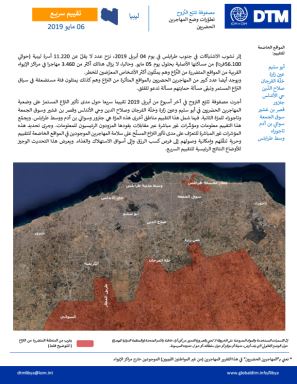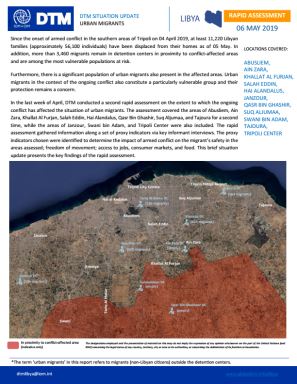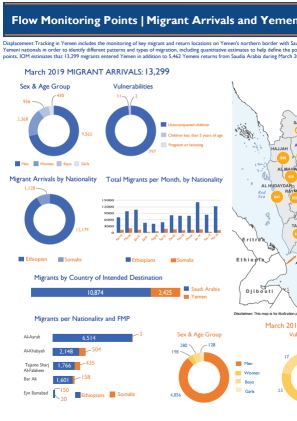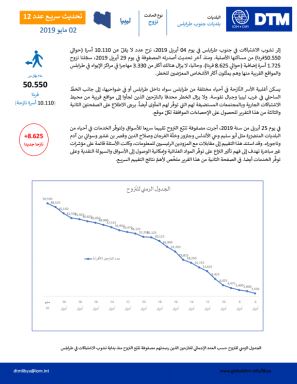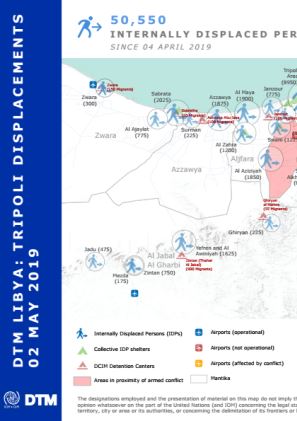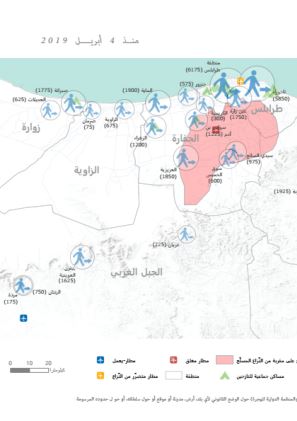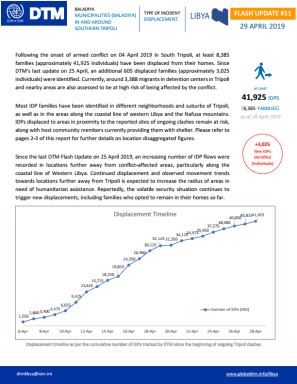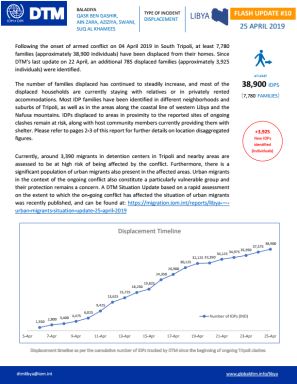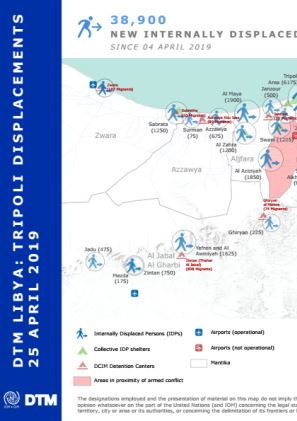-
Countries
-
Data and Analysis
-
Special Focus
-
Crisis Responses
Middle East and North Africa
DTM Middle East and North Africa
DTM Operations in the region
- Active DTM operation
- Past DTM operation
(ليبيا- تطورات وضع المهاجرين الحضريين في طرابلس التحديث 2 (06 مايو 2019
إثر نشوب الاشتباكات في جنوب طرابلس في يوم 04 أبريل 2019، نزح عدد لا يقلّ عن 11.220 أسرة ليبية (حوالي 56.100فردا) من مساكنها الأصلية بحلول يوم 05 مايو.
Libya — Tripoli Urban Migrants Situation Update #2 (06 May 2019)
Since the onset of armed conflict in the southern areas of Tripoli on 04 April 2019, at least 11,220 Libyan families (approximately 56,100 individuals) have been displaced from their homes as of 05 May.
Yemen — Flow Monitoring Dashboard (March 2019)
Displacement Tracking in Yemen includes the monitoring of key migrant and return locations on Yemen's northern border with Saudi Arabia and southern coastal border.
May 06 2019
Yemen — Flow Monitoring Dashboard (March 2019)
( التحديث السريع عدد 12 لمصفوفة تتبع النزوح: النزوح من طرابلس (02 مايو 2019
Following the onset of armed conflict on 04 April 2019 in South Tripoli, at least 10,110 families (approximately 50,550 individuals) have been displaced from their homes.
خريطة عدد 6 لنزوح طرابلس
Following the onset of armed conflict on 04 April 2019 in South Tripoli, at least 10,110 families (approximately 50,550 individuals) have been displaced from their homes.
May 02 2019
خريطة عدد 6 لنزوح طرابلس
Tripoli Flash Update 12 (02 May 2019)
Following the onset of armed conflict on 04 April 2019 in South Tripoli, at least 10,110 families (approximately 50,550 individuals) have been displaced from their homes.
May 02 2019
Tripoli Flash Update 12 (02 May 2019)
Tripoli Displacement Map #6 (02 May 2019)
Following the onset of armed conflict on 04 April 2019 in South Tripoli, at least 10,110 families (approximately 50,550 individuals) have been displaced from their homes.
May 02 2019
Tripoli Displacement Map #6 (02 May 2019)
Iraq — Protracted Displacement Study: An in-depth analysis of the main districts of origin (May-December 2018)
In November 2018, the International Organization for Migration’s (IOM) Displacement Tracking Matrix (DTM) Unit, the Returns Working Group (RWG), and Social Inquiry, with input and support from the Ministry of Migration and Displacement (MoMD) within the Federal Government of Iraq, published an in
Iraq — Protracted Displacement Study: An in-depth analysis of the main districts of displacement (May-December 2018)
In November 2018, the International Organization for Migration’s (IOM) Displacement Tracking Matrix (DTM) Unit, the Returns Working Group (RWG), and Social Inquiry, with input and support from the Ministry of Migration and Displacement (MoMD) within the Federal Government of Iraq, published an in
Iraq — Return Index: Findings Round Three (March 2019)
Of the assessed returnee population, 11 per cent (472,350 individuals) are living in high severity conditions across 279 locations. Ninewa and Salah al-Din governorates host the highest number of returnees living in these conditions with 213, 372 and 187,812 individuals, respectively.
(خريطة عدد 5 لنزوح طرابلس (29 أبريل 2019
Following the onset of armed conflict on 04 April 2019 in South Tripoli, at least 8,385 families (approximately 41,925 individuals) have been displaced from their homes.
Apr 29 2019
(خريطة عدد 5 لنزوح طرابلس (29 أبريل 2019
Tripoli Flash Update 11 (29 April 2019)
Following the onset of armed conflict on 04 April 2019 in South Tripoli, at least 8,385 families (approximately 41,925 individuals) have been displaced from their homes.
Apr 29 2019
Tripoli Flash Update 11 (29 April 2019)
Tripoli Displacement Map #5 (29 April 2019)
Following the onset of armed conflict on 04 April 2019 in South Tripoli, at least 8,385 families (approximately 41,925 individuals) have been displaced from their homes.
Apr 29 2019
Tripoli Displacement Map #5 (29 April 2019)
( التحديث السريع عدد 11 لمصفوفة تتبع النزوح: النزوح من طرابلس (29 أبريل 2019
Following the onset of armed conflict on 04 April 2019 in South Tripoli, at least 8,385 families (approximately 41,925 individuals) have been displaced from their homes.
Tripoli Flash Update 10 (25 April 2019)
Following the onset of armed conflict on 04 April 2019 in South Tripoli, at least 7,780 families (approximately 38,900 individuals) have been displaced from their homes.
Apr 25 2019
Tripoli Flash Update 10 (25 April 2019)
التحديث السريع عدد 10 لمصفوفة تتبع النزوح: النزوح من طرابلس
Following the onset of armed conflict on 04 April 2019 in South Tripoli, at least 7,780 families (approximately 38,900 individuals) have been displaced from their homes.
Libya — Urban Migrants Situation Update (25 April 2019) (Arabic)
ما فتئ عدد الأشخاص المتضررين يرتفع منذ نشوب النزاع المسلّح في المناطق الجنوبية من طرابلس في يوم 04 أبريل 2019، إذ أنّ ما لا يقلّ عن 7.515 أسرة (حوالي 37.575 فردا) قد نزحت من مساكنها.
Tripoli Displacement Map #4 (25 April 2019)
Following the onset of armed conflict on 04 April 2019 in South Tripoli, at least 7,780 families (approximately 38,900 individuals) have been displaced from their homes.
Apr 25 2019
Tripoli Displacement Map #4 (25 April 2019)
Libya — Urban Migrants Situation Update (25 April 2019)
Since the onset of armed conflict in the southern areas of Tripoli on 4 April 2019, the number of people affected has significantly increased, with at least 7,515 families (approximately 37,575 individuals) displaced from their homes.
(خريطة عدد 4 لنزوح طرابلس (25 أبريل 2019
Following the onset of armed conflict on 04 April 2019 in South Tripoli, at least 7,780 families (approximately 38,900 individuals) have been displaced from their homes.
Apr 25 2019
(خريطة عدد 4 لنزوح طرابلس (25 أبريل 2019
Monthly Regional Update — WCA, MENA, EHA (February 2019)
The DTM Monthly Regional Update contains consolidated summary updates and highlights from DTM field operations.
مصفوفة تتبّع النزوح : النّزوح من طرابلس 22 أبريل 2019
Following the onset of armed conflict on 05 April 2019 in South Tripoli, at least 6,425 families (approximately 32,125 individuals) have been displaced from their homes.
Tripoli Displacement Map #3 (22 April 2019)
Following the onset of armed conflict on 05 April 2019 in South Tripoli, at least 6,995 families (approximately 34,975 individuals) have been displaced from their homes.
Apr 22 2019
Tripoli Displacement Map #3 (22 April 2019)
Pagination
Pagination
- First page
- Previous page
- …
- 31
- 32
- 33
- 34
- 35
- 36
- 37
- 38
- 39
